Sustainable development policy and implementation in UK housing
Added on 2022-12-27
26 Pages7562 Words29 Views
Sustainable development policy and
implementation in UK housing
1
implementation in UK housing
1
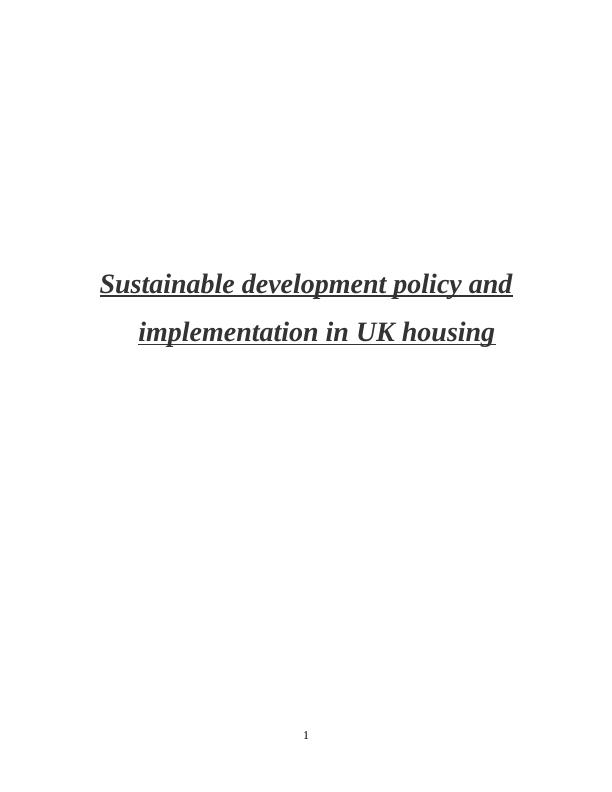
PROPOSED TITLE – “Sustainable development policy and implementation in
UK housing”
CHAPTER 1 – INTRODUCTION (2500)
1.1 Introduction to the introduction
Introduction is the very first chapter in research study which includes overview of the
study along with the various areas and topics covered in it. This chapter provides brief overview
which help reader in understanding about what is covered in the overall dissertation. It covers a
brief background of study, rationale of selecting this study, research problem, historical
perspective of topic, research aim, objectives and research questions along with methodology
outline. At last, a brief summary of the chapter is provided.
Background of the study
In United Kingdom, housing represents largest non-financial asset class; it's net value
passed 5 trillion pounds’ mark in year 2014. Around 30 percent of homes are owned outright
through their occupants as well as further 40 percent are owner-occupied on mortgage. In half of
the European union countries, United Kingdom ranks the top with regard to quality of housing,
amenities and rooms per person. However, the housing cost as an income proportion is higher
than an average among European union countries. The rising housing cost in United Kingdom
may constitute crisis for some, especially those in high cost areas like London or in low income
brackets. The stock of housing in United Kingdom was occupied and privately owned apartments
and houses, local authority rented and privately rented accommodation as well as the property
manager through housing associations.
In early 20th century, below 10% of all houses owner occupied, however by early 21st
century, the figure had improved and risen to about 62 percent - just above European union
average. There were just over twenty-seven million households in United Kingdom by year 2017
(The Housing Market, 2021). This demonstrates that the importance of local authority housing
has decreased, whereas renting privately as well as by housing association schemes has risen. In
United Kingdom, the property which is privately owned is either leasehold or freehold. The
leasehold ownership means land is not owned and owner buy the right to utilise property or land
for the specific period of time. When the lease is first granted, then this time period is usually
2
UK housing”
CHAPTER 1 – INTRODUCTION (2500)
1.1 Introduction to the introduction
Introduction is the very first chapter in research study which includes overview of the
study along with the various areas and topics covered in it. This chapter provides brief overview
which help reader in understanding about what is covered in the overall dissertation. It covers a
brief background of study, rationale of selecting this study, research problem, historical
perspective of topic, research aim, objectives and research questions along with methodology
outline. At last, a brief summary of the chapter is provided.
Background of the study
In United Kingdom, housing represents largest non-financial asset class; it's net value
passed 5 trillion pounds’ mark in year 2014. Around 30 percent of homes are owned outright
through their occupants as well as further 40 percent are owner-occupied on mortgage. In half of
the European union countries, United Kingdom ranks the top with regard to quality of housing,
amenities and rooms per person. However, the housing cost as an income proportion is higher
than an average among European union countries. The rising housing cost in United Kingdom
may constitute crisis for some, especially those in high cost areas like London or in low income
brackets. The stock of housing in United Kingdom was occupied and privately owned apartments
and houses, local authority rented and privately rented accommodation as well as the property
manager through housing associations.
In early 20th century, below 10% of all houses owner occupied, however by early 21st
century, the figure had improved and risen to about 62 percent - just above European union
average. There were just over twenty-seven million households in United Kingdom by year 2017
(The Housing Market, 2021). This demonstrates that the importance of local authority housing
has decreased, whereas renting privately as well as by housing association schemes has risen. In
United Kingdom, the property which is privately owned is either leasehold or freehold. The
leasehold ownership means land is not owned and owner buy the right to utilise property or land
for the specific period of time. When the lease is first granted, then this time period is usually
2
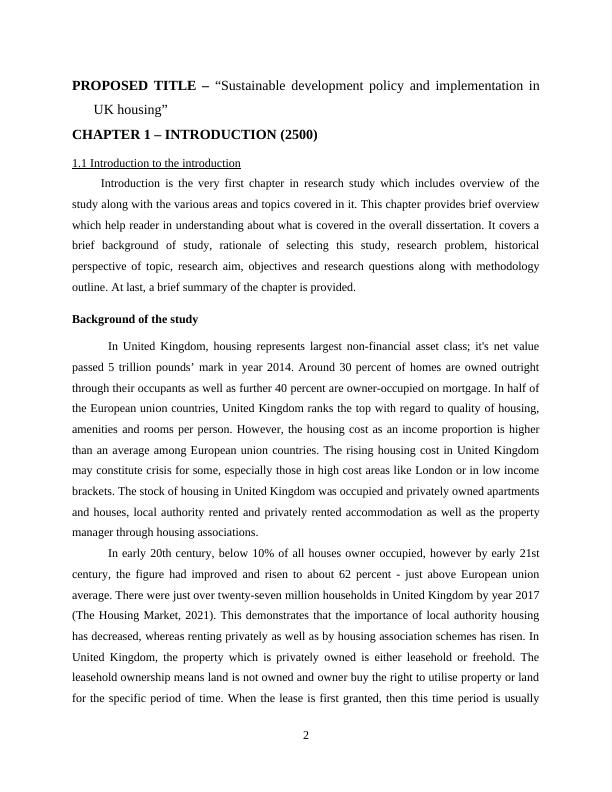
over hundred years. On the other hand, the freehold ownership means land is owned and the
property on land. The landlord rent out property by short tenancy agreement with privately
rented property, usually for six months, although it can be renewed. A monthly rent is paid by
the tenants, although other payment periods might exist. The housing associations provide
affordable properties for part rental and part ownership. This market is unlike various other
markets provided the relative significance of second hand transactions, in comparison to
purchase of newly developed properties.
As per the largest mortgage lender of United Kingdom, the Nationwide Building Society,
around 5 percent of transactions include new properties purchase. Indeed, the 95 percent of
transactions include purchase of either modern property (property build post 1945) or old
property (property build before initiation of second world war). There are two key reasons due to
which the housing market in United Kingdom is extremely important. First is that housing
usually representing biggest single purchase of household and house signify largest single item
of wealth of consumer. Second is that changes in the prices of house can have considerable
influence on rest of the economy. Thus, in UK housing industry, sustainable development is a
significant concept. Apart from this, execution of sustainable housing policy in United Kingdom
housing help in improving the sustainable housing development. This research study is based on
Sustainable development policy and implementation in UK housing and it intent to analyse the
significance of sustainable housing development and execution of sustainable housing policy in
UK housing.
Rationale for the study
This study is based on the topic “Sustainable development policy and implementation in
UK housing” and it aims analyse the significance of sustainable housing development and
execution of sustainable housing policy in UK housing. The main reason behind choosing this
study is that the housing market of United Kingdom is consistently growing. It has been
observed that the Northern Housing market is outperforming the south. There is high demand of
sustainable housing in the market which makes the study significant to perform. Apart from this,
sustainable concept is applied in housing industry which means more re-use and recycling, less
waste, along with low costs and lifecycle environment influences, less maintenance, higher user
satisfaction and better reliability. Sustainability housing development help in mitigating the
3
property on land. The landlord rent out property by short tenancy agreement with privately
rented property, usually for six months, although it can be renewed. A monthly rent is paid by
the tenants, although other payment periods might exist. The housing associations provide
affordable properties for part rental and part ownership. This market is unlike various other
markets provided the relative significance of second hand transactions, in comparison to
purchase of newly developed properties.
As per the largest mortgage lender of United Kingdom, the Nationwide Building Society,
around 5 percent of transactions include new properties purchase. Indeed, the 95 percent of
transactions include purchase of either modern property (property build post 1945) or old
property (property build before initiation of second world war). There are two key reasons due to
which the housing market in United Kingdom is extremely important. First is that housing
usually representing biggest single purchase of household and house signify largest single item
of wealth of consumer. Second is that changes in the prices of house can have considerable
influence on rest of the economy. Thus, in UK housing industry, sustainable development is a
significant concept. Apart from this, execution of sustainable housing policy in United Kingdom
housing help in improving the sustainable housing development. This research study is based on
Sustainable development policy and implementation in UK housing and it intent to analyse the
significance of sustainable housing development and execution of sustainable housing policy in
UK housing.
Rationale for the study
This study is based on the topic “Sustainable development policy and implementation in
UK housing” and it aims analyse the significance of sustainable housing development and
execution of sustainable housing policy in UK housing. The main reason behind choosing this
study is that the housing market of United Kingdom is consistently growing. It has been
observed that the Northern Housing market is outperforming the south. There is high demand of
sustainable housing in the market which makes the study significant to perform. Apart from this,
sustainable concept is applied in housing industry which means more re-use and recycling, less
waste, along with low costs and lifecycle environment influences, less maintenance, higher user
satisfaction and better reliability. Sustainability housing development help in mitigating the
3
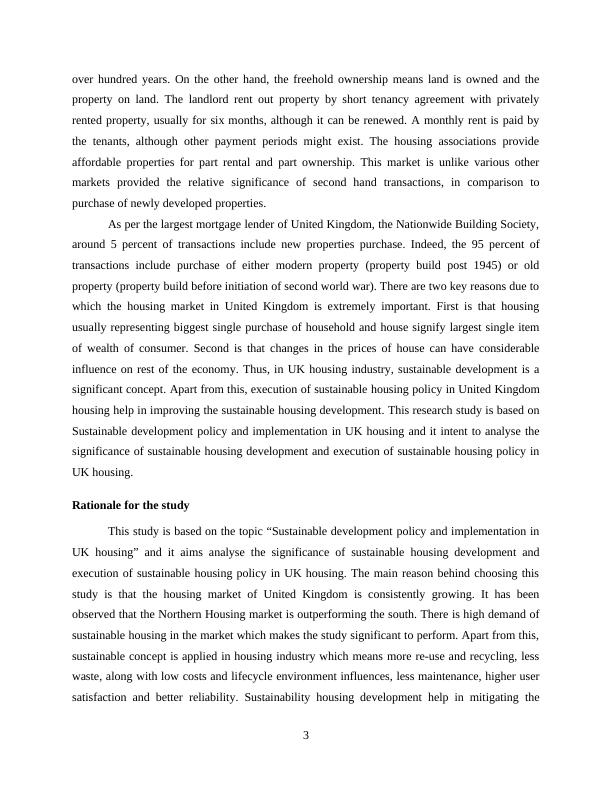
existing requirements without compromising future generation’s ability to mitigate the own
needs.
Thus, the topic is of high significance and performing research on this study area will
assist researcher in acquiring knowledge and understanding regarding sustainable housing
development, sustainable housing policy and its execution in UK Housing. This study is helpful
in understanding about the housing industry in United Kingdom along with the sustainable
housing development concept. It also helps in examining sustainable housing policy as well as its
execution in housing industry of United Kingdom. In addition to this, the researcher can assess
and unsustainability of housing and community sector in housing industry of UK through this
study. Moreover, there are various challenges that the industry faces in integrating affordable and
sustainable housing. By the assistance of this study, researcher will be able to determine these
challenges so that appropriate recommendations can be provided which contribute to the growth
of housing industry in United Kingdom.
1.2 The problem
Sustainable development is all about mitigating the needs of human as well as enhancing
their life quality through minimising adverse impacts on the environment. Now days, the areas
where people live or reside contribute greenhouse effects and CO2 emission as much as global
warming that threatens to all the individuals as well as their health. Sustainable housing
development is one of an effective way that contribute in resolving this global warming issue.
Sustainable architecture seeks to reduce the adverse impact on environment of buildings to
enhancing modernization and efficiency in utilisation of energy, development space and
materials. There are three main elements of sustainable housing - environmental sustainability,
social sustainability and economic sustainability. There are variety of innovative technologies
and design solutions incited business challenges in accommodation quality and resident's
satisfaction. The designers often strive to maintain aesthetics of the appearances of housing as
well as neglect actual requirements of clients. As compared to the commercial buildings,
residential design should correspond to daily concerns of individual's lives and address the issues
associated to ambience and life experience. Thus, in order to ensure sustainable housing
development, an optical balance among sustainable housing and the satisfaction of customers is
needed. In order to address this issue in an effective way, sustainable development policy and its
execution in housing in United Kingdom is important. The sustainable housing policy stated
4
needs.
Thus, the topic is of high significance and performing research on this study area will
assist researcher in acquiring knowledge and understanding regarding sustainable housing
development, sustainable housing policy and its execution in UK Housing. This study is helpful
in understanding about the housing industry in United Kingdom along with the sustainable
housing development concept. It also helps in examining sustainable housing policy as well as its
execution in housing industry of United Kingdom. In addition to this, the researcher can assess
and unsustainability of housing and community sector in housing industry of UK through this
study. Moreover, there are various challenges that the industry faces in integrating affordable and
sustainable housing. By the assistance of this study, researcher will be able to determine these
challenges so that appropriate recommendations can be provided which contribute to the growth
of housing industry in United Kingdom.
1.2 The problem
Sustainable development is all about mitigating the needs of human as well as enhancing
their life quality through minimising adverse impacts on the environment. Now days, the areas
where people live or reside contribute greenhouse effects and CO2 emission as much as global
warming that threatens to all the individuals as well as their health. Sustainable housing
development is one of an effective way that contribute in resolving this global warming issue.
Sustainable architecture seeks to reduce the adverse impact on environment of buildings to
enhancing modernization and efficiency in utilisation of energy, development space and
materials. There are three main elements of sustainable housing - environmental sustainability,
social sustainability and economic sustainability. There are variety of innovative technologies
and design solutions incited business challenges in accommodation quality and resident's
satisfaction. The designers often strive to maintain aesthetics of the appearances of housing as
well as neglect actual requirements of clients. As compared to the commercial buildings,
residential design should correspond to daily concerns of individual's lives and address the issues
associated to ambience and life experience. Thus, in order to ensure sustainable housing
development, an optical balance among sustainable housing and the satisfaction of customers is
needed. In order to address this issue in an effective way, sustainable development policy and its
execution in housing in United Kingdom is important. The sustainable housing policy stated
4
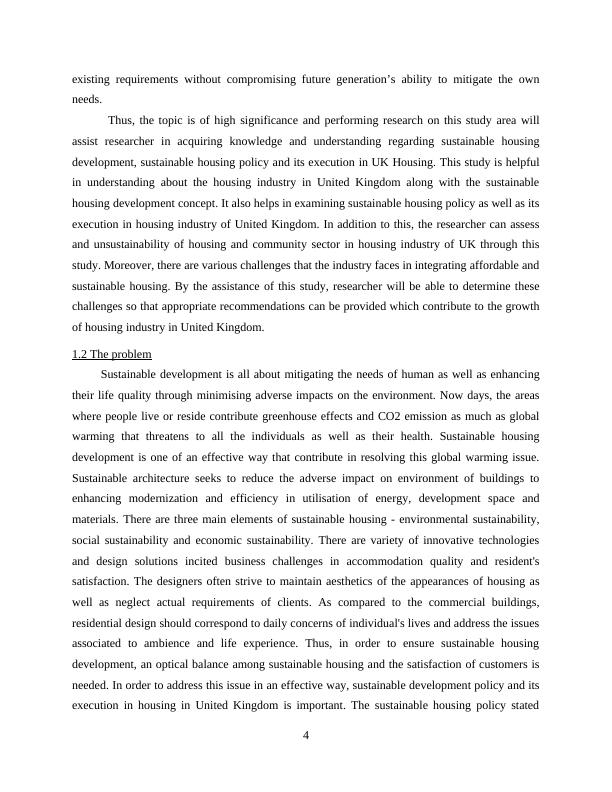
sustainability in technical environmental terms, however social dimensions exist in some
measures in policy. In the UK sustainable housing policy, much emphasis is placed on 100%
zero carbon which is the main objective of new housing as well as measures are developed to
accomplish it.
1.3 Historical perspective
The industrialized building systems in United Kingdom have not been very much
successful because of several reasons involving inconsistent policies of government.
Construction industry's industrialisation was criticized through society due to quantity was
valued more than quality. The designers failed many times to consider technical matters or issues
in conjunction with aesthetics whereas the local authorities were criticized due to losing identity
of their tenants that caused several social issues including vandalism, depression as well as other
crimes. In fact, the UK housing history and introduction of new construction methods in 20th
century are related to various factors like welfare state policies, modern architecture and world
wars that considerably impacted the sector. After world war, huge destruction outcomes in
urgent and massive requirement for new housing as well as encouraged the government of
United Kingdom to enter into housing market. Subsequently, message size of housing programs
that were outside the existing traditional building resources capacity involving skilled labour and
building materials, give a rise to the idea of executing alternative methods of construction which
were capable of utilising non skilled labourers and new materials outside the construction sector.
The general belief in the industry was that through executing advanced technologies,
housing would alter from an expensive investment of capital to easily available product. 1960s
was the era of higher rise flats executing prefabricated methods of building. But, at the similar
time arguments against these types of construction methods and buildings were becoming more
evident. In 20th century, around 1 million prefabricated houses were built that led to adverse
attitude of public towards prefabrication because of low quality design, building skills and poor
materials. The housing demand and supply was fluctuating during the 20th century, demonstrates
the cycling nature of house building in United Kingdom. There have been various busts and
bombs in the market of housing, however the general housing trend has been downward. The
new house building rate in England declines from over 250,000 pounds in mid-1970's to around
200,000 in year 1989 and 150,000 in year 2004 (Review of the UK housing history in relation to
system building, 2013). This had happed due to two key reasons - dramatic reduction in
5
measures in policy. In the UK sustainable housing policy, much emphasis is placed on 100%
zero carbon which is the main objective of new housing as well as measures are developed to
accomplish it.
1.3 Historical perspective
The industrialized building systems in United Kingdom have not been very much
successful because of several reasons involving inconsistent policies of government.
Construction industry's industrialisation was criticized through society due to quantity was
valued more than quality. The designers failed many times to consider technical matters or issues
in conjunction with aesthetics whereas the local authorities were criticized due to losing identity
of their tenants that caused several social issues including vandalism, depression as well as other
crimes. In fact, the UK housing history and introduction of new construction methods in 20th
century are related to various factors like welfare state policies, modern architecture and world
wars that considerably impacted the sector. After world war, huge destruction outcomes in
urgent and massive requirement for new housing as well as encouraged the government of
United Kingdom to enter into housing market. Subsequently, message size of housing programs
that were outside the existing traditional building resources capacity involving skilled labour and
building materials, give a rise to the idea of executing alternative methods of construction which
were capable of utilising non skilled labourers and new materials outside the construction sector.
The general belief in the industry was that through executing advanced technologies,
housing would alter from an expensive investment of capital to easily available product. 1960s
was the era of higher rise flats executing prefabricated methods of building. But, at the similar
time arguments against these types of construction methods and buildings were becoming more
evident. In 20th century, around 1 million prefabricated houses were built that led to adverse
attitude of public towards prefabrication because of low quality design, building skills and poor
materials. The housing demand and supply was fluctuating during the 20th century, demonstrates
the cycling nature of house building in United Kingdom. There have been various busts and
bombs in the market of housing, however the general housing trend has been downward. The
new house building rate in England declines from over 250,000 pounds in mid-1970's to around
200,000 in year 1989 and 150,000 in year 2004 (Review of the UK housing history in relation to
system building, 2013). This had happed due to two key reasons - dramatic reduction in
5
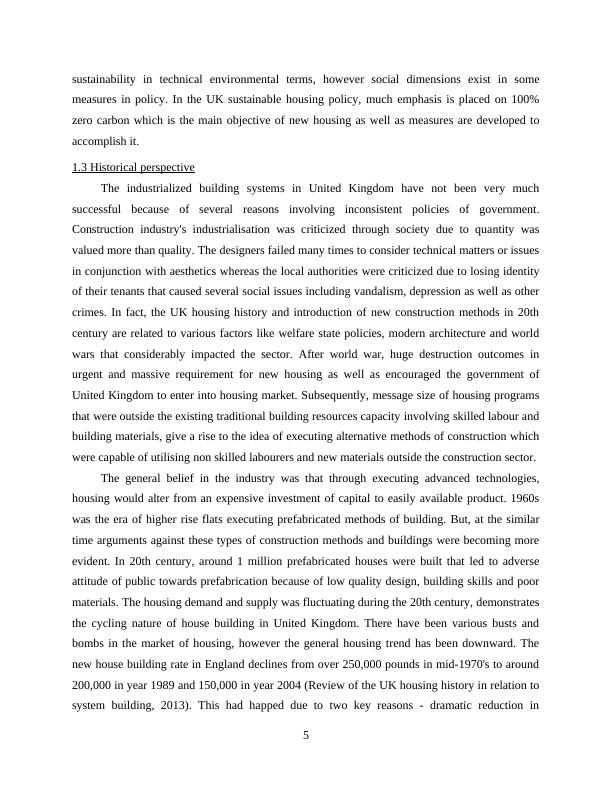
investment of government in social housing and massive decline in private sector house building
rate.
1.4 Research goals
1.4.1 Aim of research
Research aim is stated as an aspiration or intention of the research investigation. The aim
of the study summarises in a short sentence which demonstrate what the researcher hope to
accomplish at the end of the research study. The aim is a specific statement as well as phrased in
a manner that it is possible to determine when it has been accomplished. It describes the
overarching purpose or the main goal of the research dissertation and administer answer to the
researcher of research question. It is the prime focus of dissertation which is expressed in terms
of aim and is the overall purpose of performing a research.
The main aim of this research study is “To analyse the significance of sustainable housing
development and execution of sustainable housing policy in UK housing. A case study on
Housing Industry, United Kingdom.”
1.4.2 Objectives of research
The research objectives define about what the researcher expect to accomplish by the
dissertation. These are expressed in lay terms as well as directed as much to the researcher.
These may be related to the hypothesis or utilised as purpose statement in the study which
doesn't have a hypothesis. In case, if the nature of investigation has not been clear from
hypothesis, objectives enable to understand the research properly. The objectives of research can
serve to direct the activities of study and concisely describe what the investigation is trying to
accomplish. Objectives of the study involves acquiring answers to the questions or testing the
hypothesis of research. These assist researchers to emphasize on study and also help in
narrowing down it to its essentials. The main objectives in context of this particular study are
provided below:
1. To understand about the Housing industry in United Kingdom.
2. To analyse the concept of sustainable housing development.
3. To examine the sustainable housing policy and its execution in the Housing industry of
United Kingdom.
6
rate.
1.4 Research goals
1.4.1 Aim of research
Research aim is stated as an aspiration or intention of the research investigation. The aim
of the study summarises in a short sentence which demonstrate what the researcher hope to
accomplish at the end of the research study. The aim is a specific statement as well as phrased in
a manner that it is possible to determine when it has been accomplished. It describes the
overarching purpose or the main goal of the research dissertation and administer answer to the
researcher of research question. It is the prime focus of dissertation which is expressed in terms
of aim and is the overall purpose of performing a research.
The main aim of this research study is “To analyse the significance of sustainable housing
development and execution of sustainable housing policy in UK housing. A case study on
Housing Industry, United Kingdom.”
1.4.2 Objectives of research
The research objectives define about what the researcher expect to accomplish by the
dissertation. These are expressed in lay terms as well as directed as much to the researcher.
These may be related to the hypothesis or utilised as purpose statement in the study which
doesn't have a hypothesis. In case, if the nature of investigation has not been clear from
hypothesis, objectives enable to understand the research properly. The objectives of research can
serve to direct the activities of study and concisely describe what the investigation is trying to
accomplish. Objectives of the study involves acquiring answers to the questions or testing the
hypothesis of research. These assist researchers to emphasize on study and also help in
narrowing down it to its essentials. The main objectives in context of this particular study are
provided below:
1. To understand about the Housing industry in United Kingdom.
2. To analyse the concept of sustainable housing development.
3. To examine the sustainable housing policy and its execution in the Housing industry of
United Kingdom.
6

End of preview
Want to access all the pages? Upload your documents or become a member.
Related Documents
Contrast between leasehold ownership and freehold ownershiplg...
|12
|3984
|131
Factors Determining Prices of Rental Housing in UKlg...
|10
|2987
|47
Assignment About Property Lawlg...
|17
|3964
|11
